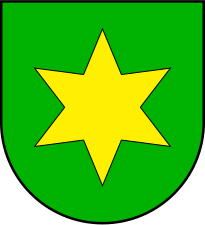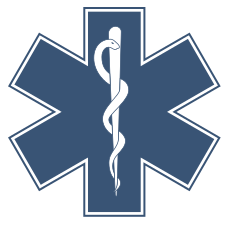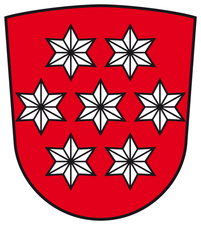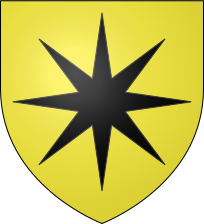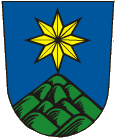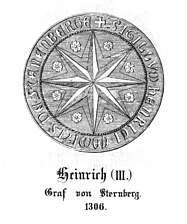Star (heraldry)

The star is a common figure in the coats of arms ( Heraldry spread).
variants
The star is depicted on its own in the heraldic shield or a heraldic field or used as a greatly simplified constellation ( Southern Cross ). As a rule, stars are shown in the 2-1 or 1-2-1 position, i.e. two more are arranged symmetrically above one star. The latter position results in a diamond and is emblazoned as such . The number of rays ranges from four to eight. Stars, like many other figures, can be placed in stakes or (diagonally) bars. Five or seven pointed stars with a downward point are emblazoned as overturned. A sunken star is six-pointed and has two upward-pointing rays that are longer than any other. The faceted design of the rays is popular because they can be tinged in multiple colors . If the tips of the star touch the edge of the coat of arms, the common figure becomes a shield division of a special kind. A four-pointed star is necessary for this. This division is called a star cross , but it is not a cross in the strict sense of the word. A special feature is the tail star or comet . The direction of the tail is important here: if the tail points down, it is a rising, otherwise a falling comet.
In Germany, the six-jet variant is primarily used. In France's coat of arms with this heraldic figure, the stars have predominantly five rays. If there are additional line-shaped rays between the star points, the coat of arms should be described as radiant .
A star with a face was emblazoned with starfish in older heraldry . The star is then formed or formed with a moon face . The animal starfish , also modified as a heraldic animal , is very rarely or not used in heraldry.
A special feature is the lowered star . Here the two upper rays of a mostly six-pointed star are elongated and that is to be emblazoned in the description of the coat of arms with "lowered star".
The sea star is a special form of the heraldic star and is emblazoned as such. A heraldic figure made up of joined triangles is shown in the shield or field, each accompanied by a six-pointed star at the fishing tips.
Symbolism and examples
In the stars and stripes of the American flag, the star is a symbol for the number of individual states. Stars are also popular in other national coats of arms and flags, such as the coat of arms of the Comoros . Or after the award by the Queen of the Netherlands in 1964, six blue stars in gold are symbols of the Netherlands Antilles . In 1975 the Republic of Benin added stars to its coat of arms. In the coat of arms of Singapore symbolize five stars peace, progress, justice and equality. In the coat of arms of Italy , the star stands for the Stella d'Italia , the state symbol of Italy.
Many Soviet cities have a gold star in their coat of arms. This was awarded to Hero Cities after the Second World War. There are Moscow, Leningrad, Kiev, Volgograd, Odessa, Kerch, Novorossiysk, Minsk, Tula, Voronezh, Murmansk, Brest Fortress (chronological information).
The Star of David is one of the few stars with a fixed name. It is a six-pointed star and is also called a hexalpha. It consists of the superimposition of an upright and a fallen equilateral triangle, intertwined in the original. The star is depicted in the coat of arms and flag of the State of Israel . Another six-pointed star is the Marienstern. He is represented twice in the coat of arms of Hamburg . There it corresponds to a filled Star of David, but it is also represented as a three-bar cross similar to the Star of Life without any further symbols.
- Gallery of six-pointed stars
Krähenberg , falling comet
Binningen , three stars by stake
Oestringen with cup ring
Stars rotated by 1/12 (30 °), Aach (Hegau)
star-like three - bar or Hagal cross , Ihlienworth
Three-bar cross (St. Andrew's cross, covered with stake), symbol of the Star of Life
seven stars: Thuringian coat of arms from 1921
City arms of Bolzano : six-pointed star on a bar
Eight-pointed star
As an eight-pointed star, the star has been used as a heraldic figure in Central Europe since the 12th century. It often serves as a talking coat of arms for families and communities with the Sternberg name reference . In some cases in the coat of arms the star in the shield is above a mountain of three . The star can be simple or sharpened, which means that a thin line in each ray runs centrally to the center of the figure. This peculiarity is to be mentioned in the description of the coat of arms .
The eight-pointed star appears frequently in English , French and Italian coats of arms. The heraldry of these countries knows stars from five to eight rays. The six-pointed stars are common in German heraldry.
The star is eight-pointed in the coats of arms of the Bohemian nobility of Sternberg or in those of the Schwalenberger dynasties . It is also represented in the coats of arms of Waldeck and Bad Wildungen (in the latter, however, compressed). The counts Sternberg (areas south of the River Weser in today's lip ), Waldeck and Schwalenberg all came in direct line from Wide Child I. from.
This form of the star, colloquially referred to as the Sternberg star , has also been adopted in the coats of arms of the former old districts of Lemgo and Detmold , but in a simplified, broad form. It is also still present in a broad form in the municipal coat of arms of Extertal (part of the former Grafschaft Sternberg ). It even appears as the original Sternberg star in the coat of arms of the city of Bad Salzuflen . Quotation from this Bad Salzufler brochure: A council seal has been documented since 1375. The seal image shows the basic motif of the city's coat of arms, which is still used today, the SALT FOUNTAIN AND THE STERNBERGER STERN.
In Perleberg's coat of arms , the star is surrounded by a pearl and the pearl is surrounded by a string of pearls. Eight silver pearls accompany the star between the rays. The coat of arms is talking. The Perlebergers call the coat of arms the Perleberger Stern . It has been in the coat of arms since around 1300.
From a geometrical point of view, it is rotationally invariant with the rotation of an eighth circle around its center point and the interior angle of each star point is 360/16 ° = 22.5 °. In the simplified serrated shape, this angle is doubled to 45 ° so that the serrated edges point to opposite star points. Historically, however, points have been constructed with arbitrary angles in between and even pointed star points (angles smaller than 1/16 of the full circle).
- Gallery of eight-pointed stars
Coat of arms of Bösingfeld (administrative seat of the County of Sternberg )
Coat of arms of Schwalenberg (today part of Schieder-Schwalenberg )
Coat of arms of the principality of Waldeck
Coat of arms of the Waldeck district (Hesse)
Sternberg in Mecklenburg-Western Pomerania
Šternberk in Moravia, Czech Republic
Český Šternberk in Bohemia, Czech Republic
Bojkovice in Moravia, Czech Republic
Coat of arms of the Counts of Sternberg in Bohemia
City arms of Perleberg in Brandenburg until Nov. 2009
See also
- Drudenfuß (heraldry)
- Red star in coat of arms and on flags
- Constellation in the coat of arms
- Five-pointed and six-pointed star as a popular mint master mark of the mint masters of the Wettin mints Zwickau (1440–1449 / 1469–1470), Sangerhausen (1442–1449), Leipzig (1462–1477 / 1507–1511), Annaberg (1499–1511 / 1542–1555 ), Schneeberg (1497–1498) and Freiberg (1546–1555). See tables of the mint masters of the mints.
Individual evidence
- ↑ heraldik.se (Swedish): Dags att bli bildad: Allmänna bilder (Time to form: Various coats of arms) ( Memento from March 27, 2013 in the Internet Archive ) accessed on June 14, 2014.
- ^ Oskar Mothes : Illustrated building lexicon. Booklet 15. Otto Spamer, Leipzig 1864, p. 138.
- ^ Johann Siebmacher, Hilmar Hermann Weber: Large and general Wappenbuch. Verlag Bauer und Raspe, Nuremberg 1890, (reprint Verlag Рипол Классик) ISBN 978-5-88134-235-7 , p. 111.
- ^ Oscar Mothes: Illustrated Construction Lexicon. Volume 2, Verlagbuchhandlung Otto Spamer, Leipzig / Berlin 1866, p. 138.
- ↑ Explanations of Heraldry, as a commentary on Hofrath Gatterer's outline of this science. Volume 1, Verlag Adam Gottlieb Schneiderischen Kunst- und Buchhandlung, Nuremberg 1789, p. 86.
- ↑ a b Gert Oswald : Lexicon of Heraldry. Bibliographisches Institut, Leipzig 1984, p. 382.
- ↑ St. Marienstern Monastery
- ↑ www.staatsbad-salzuflen.de
- ↑ Heinz Machatscheck: Entertaining heraldry. Verlag Neues Leben, Berlin 1981, p. 187.





